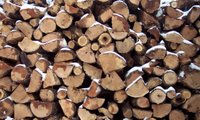Two kinds of knots may pop up in – or out of – your wood: red knots and black knots.
 |
| Red knots |
Knotty pine, the paneling so fashionable in the 1940s and ’50s, owed its design to red knots, which are well-fastened to the wood around them. Black knots, however, tend to loosen and pop out.
To most woodworkers, especially furniture-makers, all knots are bad. Because they expand and contract differently from the wood around them, and may have different densities, they can lead to uneven finishes and often weakened structures.
Black knots can simply fall out, resulting in knot holes, which can significantly weaken the wood and, in a table top or door, provide an awkward opening.
So especially if it’s black, you would not want a wood knot.






